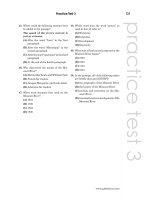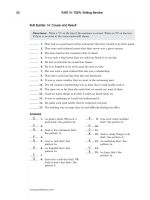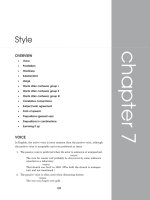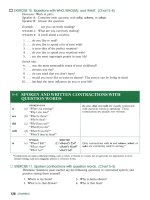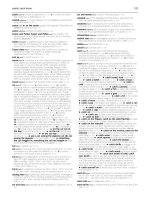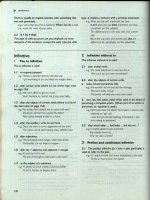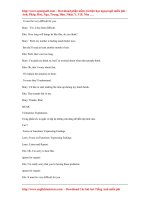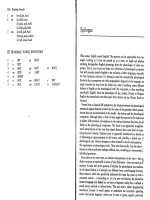Your writing coach part 21 pps
Bạn đang xem bản rút gọn của tài liệu. Xem và tải ngay bản đầy đủ của tài liệu tại đây (107.43 KB, 10 trang )
“Tell me what it’s about first,” the VIP says. “Then I can
decide whether or not to read it. You have until we reach the 35th
floor.”
Uh-oh. You begin, “Well, it’s about this man, he has a great
life in most ways—a happy marriage, two lovely children, a good
job, you know, something in the City, he makes a good living,
and his health is fine, too.” You’re already passing the 10th floor
and the VIP’s eyes are starting to glaze over just a tiny bit. “But
he has a problem—by the way, his name is Bob Finster, and he’s
in his mid-30s. Or late 30s. Or even 40s, depending on casting,
because in the movie version this would be a great part for a star.
I was thinking Bruce Willis originally, but maybe he’s a little too
old now… Russell Crowe would be good, but I hear he’s tem-
peramental. Anyway, Bob has this problem…” Twentieth floor,
and the VIP is looking more depressed than ever.
I won’t take us all the way to the 35th floor, but I trust the
point is obvious. Producer Stephen Cannell said it best in an
interview I did with him years ago: “A good idea, badly pre-
sented, sounds like a bad idea.”
You may be thinking it’s not too likely that you’ll be having
an enc
ounter in a lift with the VIP any time soon, and that’s true.
However, it’s quite likely that if you’re making any effort at all to
get people to read your work or listen to your ideas, you will be
encountering agents, editors, or producers. And in every case,
before they actually read anything you’ve written, they will want
to hear what it’s about, either in a brief verbal pitch or a letter
that’s the written equivalent of a pitch. If that’s not compelling,
you’ve hit the end of the trail.
So what are the secrets of making an effective pitch? Here are
eight crucial guidelines:
✐ Let them know what kind of story you’re talking about.IfI tell
you that my story is about a man whose mid-life crisis
motivates him to do all the things he never did in his mild
youth, that could be a comedy—but it could also be a
drama in which he endangers his marriage and career. If
192 Sell!
you start by telling the other person the genre, if it’s a com-
edy they will be listening for what makes the story funny; if
it’s a horror story they’ll be listening for what will provide
the chills.
✐ Hook them before you provide any back story. In the lift exam-
ple, it would be far better to start by saying, “The main char-
acter, Bob Finster, is a man in his mid-30s who is missing
only one thing in his life.” That makes your listener wonder
what this one thing is. Now you can briefly tell him a few of
the things Bob is not missing—“he has a great wife and kids,
a lucrative job, his health is good”—and then you can satisfy
the VIP’s curiosity by revealing what Bob is missing.
Let me give you an example from my own experience. Some time
ago, I was pitching an idea for an American television film about
the second wife of President Woodrow Wilson. The first time I
pitched it, I started at the beginning:
The story opens in the White House in 1915. Woodrow
Wilson is in office, and his wife has just died…
It didn’t take long for the listener to lose interest (people in
Hollywood have the attention span of a gnat). I revised the pitch
to this:
These days, the notion of a woman president isn’t a ques-
tion of whether, but of when. Maybe it’ll be Hillary
Clinton, maybe it’ll be Condoleezza Rice, or maybe it’ll be
someone we haven’t heard of yet. But actually we have
already had a de facto woman president. This woman
made appointments to the Cabinet. When the Queen of
England visited the United States, this woman caused a
scandal by refusing to curtsy because she felt she was of
equal stature. She took on Congress for several months—
and won. She was Woodrow Wilson’s second wife, and
this is her story.
Marketing Yourself 193
This opening sparked the listener’s interest; then I was able to
back-track and tell the story from the start. This was a longer
pitch; if it had been an elevator pitch, I would have shortened the
teaser to, “Did you know that America has already had a woman
president?” Of course, I would have had to qualify that a bit, but
it’s definitely an attention getter. In case you’re curious, I haven’t
sold the project—yet. I’ve put it back in the drawer, to be pulled
out the first time a woman gets nominated for the presidency.
✐ Make your characters individuals. You don’t have much time
to describe your main characters, so you have to be concise
and colorful in providing a mental image of them. In some-
thing I’ve written recently, a character named Bloom is a bit
of a con artist, and I’d describe him as short, overweight,
and always sweating a little. You don’t have time to do this
for all your characters, just the main two or three. The oth-
ers will have to be described by their functions—the land-
lady, the taxi driver, the lonely neighbor. Don’t give
everybody names, because it takes too long and it’s hard for
the listener to remember who’s who.
✐ Get to the meat of the story fast. It’s tempting to spend a lot
of time on the set-up, the call to adventure—the beginning
(in scripts this is Act One of the three acts). Generally, Act
One is fun, but it’s in Act Two, the middle, that we find the
meat of the story. It’s also where most manuscripts and
scripts and ideas fall down. In a brief pitch (or letter) you
don’t have time to go into all of the developments of your
story, but you should tell three or four major developments
that escalate the conflict, and you certainly will want to
include the “moment of truth” at the end of Act Two, the
highest point of crisis. (If any of these references are confus-
ing to you, you probably haven’t read Chapter 9, about
structure, so it might be a good idea for you to do that now,
and then come back.)
✐ Don’t leave out Act Three, the ending. Some people think it’s
cool to leave the listener hanging, the idea being that if they
194 Sell!
want to hear how the story comes out, they will have to buy
the manuscript or script. Wrong. Too many stories have
illogical or otherwise weak endings, so your listener wants
to make sure that yours will not.
✐ Weave your theme into your story. If the story includes a
theme or lesson, try to incorporate it in your story naturally
rather than stating it separately at the end. I’ve already
referred to the classic film comedy Tootsie, in which Dustin
Hoffman plays a failed actor who disguises himself as a
woman in order to get work. In a pitch you could include a
statement something like this: “Ironically, it’s only as he
experiences being a woman that he begins to understand
how to be a better man. Now he’s ready to find true love
with the woman he works with—but he can’t reveal his real
identity without losing his new success as an actor.” The first
statement is the theme, the second relates it to the plot.
✐ Tell your story with enthusiasm. When I was publishing the
Hollywood Scriptwriter newsletter, I asked the agents, pro-
ducers, story editors, and studio and network executives the
same question: “What is the one most important quality of
a good pitch?” Unanimously, they said enthusiasm. If you
don’t sound like you really believe in your story, why should
they believe in it? If you are an introvert, as many writers
are, find a way to show your enthusiasm that feels comfort-
able and natural. This can be as simple as putting an extra
bit of energy or warmth into your voice.
✐ Practice! If you do a bad pitch in a workshop, or in front of
your spouse or partner, or your dog, or the mirror, no harm
done. You want to make your mistakes before you are actu-
ally talking to someone who can help (or hurt) your career,
so practice as often as you can.
Once you realize that pitching is really just another version of
what you love to do—telling stories—it loses its power to
intimidate.
Marketing Yourself 195
The query letter
The query letter is just the written version of a verbal pitch, with
the advantage that you can take your time over it and hone it
until it does a great, concise job of sparking the reader’s interest.
If you are proposing an article, the reader will be an editor at a
magazine; if you are seeking representation, it will be an agent; if
you are trying to sell a screenplay, it will be a producer or net-
work executive. Here is an example of such a letter:
Dear Agent [Naturally this would be the name of a
specific agent]
I would love to have the opportunity to send you a copy
of my novel, a thriller called “The Devil’s Choice.”
The story opens in 1945. Deep in the Philippine jungle,
there’s a small hut with a dirt floor. A prisoner is col-
lapsed in the corner
, beaten nearly to death by Japanese
interrogators. Donald Trent is one of a elite group of 12
American soldiers, caught during a night drop that went
horribly wrong. When his captors realize Trent knows
about the secret weapon being developed by the
American government, they give him a terrible choice:
Reveal what he knows, or Japanese agents in America
will kill his entire family.
Trent gambles the future of his country by telling what
he knows—but then leads his men in a daring escape
and a harrowing pursuit of the messengers hand carry-
ing the secret of the atomic bomb to the Emperor in
Tokyo.
In the showdown inside the city itself, Trent sacrifices
his life, but eliminates the thr
eat to his family and
ensures that the secret of the atomic bomb dies with
him.
196 Sell!
Although the story is fiction, I have based many of its
elements on historical fact. I spent six months in Japan,
researching this era and the Japanese spy services dur-
ing World War II.
If you would like to read “The Devil’s Choice,” please
return the stamped, self-addressed postcard I have
enclosed, or contact me via phone or email. I look for-
ward to hearing from you.
Sincerely,
A Writer
Let’s take a look at the elements in this letter. The first paragraph
tells the genre of the novel and its name. The second creates a
dramatic image in the mind of the reader, introduces the protag-
onist, and sets up his central conflict. The third paragraph sum-
marizes the crucial elements of the middle of the book.
Naturally, one short paragraph can’t begin to cover all of the
exciting adventures the writer might have in mind for this part
of the book, but there’s enough there to whet the appetite. The
next paragraph reveals the resolution of the story, including the
fact that the protagonist sacrifices his life. The one after that
reveals information that gives credibility to the writer, namely
that a lot of research has gone into this story. The final paragraph
wraps things up and indicates that a stamped, self-addressed
postcard is enclosed.
This is a concise and effective model that you can use for any
query letter you write when you have a finished work you’d like
someone to read.
Next, overleaf is the query letter that I wrote for the book you
are reading now:
Marketing Yourself 197
Dear (Publisher)
I suspect if you had a penny for every time someone said
to you, “I’d write a book if I only had the time,” you’d be
a richer man. These people are the target audience for the
book described in the enclosed proposal. It’s called “Your
Writing Coach,” and actually it will appeal both to
would-be and practicing writers. As you’ll see, it covers
motivation, writing short-cuts, and the most important
psychological aspects of writing, as well as specific time
management techniques for writers.
I am the co-author of
Successful Scriptwriting, published
by Writers Digest Press, which sold more than 65,000
copies. My most recent book,
Do Something Different, is in
its second edition from Virgin Books and has been trans-
lated into Chinese, Spanish, Korean, and Bulgarian, and
sold a special run of 8,000 copies for the Institute of
Chartered Accountants. I am also a successful
scriptwriter, with credits that include
Family Ties, Benson,
Love Boat, Relic Hunter, and many other series and TV
movies.
I hope this manuscript will be of interest to you. I have
enclosed a stamped, self-addressed envelope, and I look
forward to hearing from you.
Sincerely,
Jurgen Wolff
In this case, the query letter was accompanied by a full proposal
for the book, so the letter was short. It began with a question that
I hoped would capture the attention of the reader. I was confi-
dent that anybody in the publishing field hears the “I’d write a
book if I only had the time” comment at least once a day, so I felt
this would be a good opening. The paragraph then gives a very
198 Sell!
brief indication of the book’s contents; just enough, I hoped, to
lead the reader to the fuller proposal.
Almost half the letter refers to my publishing history and
experience as a writer. For non-fiction books, it’s important that
you have relevant expertise. If you’ve had some success selling
books in the past, that also is important to mention because it
instills confidence that you will do it again.
Query letters for articles
If you are proposing to write an article for a magazine, you
would write a similar letter. Your first paragraph might start with
a “hook,” a statement that grabs the reader’s interest right away.
For example, for an article covering a new approach to helping
people quit smoking, it might be, “The average success rate for
hypnotists who try to help people quit smoking is 63%. Dr.
Franklin Arbuthnot’s success rate, independently verified, is
95%.” The rest of the paragraph might summarize his innovative
approach, and reveal that the doctor is willing to give you his first
interview ever about his technique. You might also mention two
medical experts you plan to have comment on his work, and that
you will supply photos of clients undergoing this treatment. Your
second paragraph would give your background, including publi-
cations that have carried your work in the past. You could also
include a couple of clippings of your previous work, so the edi-
tor can see your writing style.
Query letter dos and don’ts
When you write letters like this, make sure that any experience
you mention does relate to the project you are proposing. I’ve
seen letters in which writers have cited irrelevant academic
achievements or skills and even their hobbies. This is a waste of
valuable space and also is distracting.
Marketing Yourself 199
It’s important that these letters go to a named individual, not
just to “The Editor,” and that the name be spelled correctly. If in
doubt, always check first. Most publishers, agencies, and pro-
duction companies have websites that include the names of
their key employees or at least a contact telephone number.
Don’t hesitate to ring a company and say, “I’m sending a pack-
age to Mr. X, and I just wanted to double-check the spelling of
his name.”
Try to keep your letters to one page. Editors are busy people,
so the more you can give them the vital information in a precise
and concise form, the more they will appreciate it.
What goes into a book proposal?
If you are trying to sell a short story, a first novel, or a screenplay,
potential buyers will expect you to have written it all before you
approach them. So much of the value in a work of fiction is its
execution, not just its idea, that they generally want to see the
whole project in order to evaluate it. Once you’ve had some suc-
cess as a fic
tion writer, you can switch to getting commissions for
further books or scripts based on pitches or query letters.
However, for non-fiction books, the standard procedure is to
submit a book proposal. The components of the proposal are:
✐ A query letter like the one above.
✐ A title page with the name of the book, your name, and your
contact details.
✐ A table of contents for the proposal itself.
✐ An introduction that serves as an overview of the book you
are proposing. This would include why you think the book
is needed, how long it is, how far along you are in writing it,
how long it would take for you to deliver the completed
manuscript, and any special features it will offer.
✐ Markets for the book: who your target buyers are, and why
they will find this book appealing.
200 Sell!
✐ Promotion: how you will help promote the book. This is
becoming more and more important. Publishers’ promotion
money is stretched and frankly quite often it goes to their
already successful authors. If you can show you have con-
crete plans for making people aware of your book, that will
be very appealing to a publisher. In this context, you may
run across the term “platform” or “author’s platform.” What
this refers to is your ability to spread the word to people
who are already aware of you. If you have a popular e-bulletin
or newsletter or podcast, for example, or you address big
groups every year, you have a platform. If you don’t have
one, your proposal should indicate how you would go about
establishing one. This doesn’t mean you have to be famous
in a general sense, only in the area you are addressing in
your book. If it’s a gardening book, then you have to show
how you will become known within the world of gardening
fans.
✐ Competitive and complementary books: a brief look at what
similar books are out there already, how successful they have
been, and what is different about your book. By the way,
you mig
ht think if there are no other books out about your
topic this will be a hot selling point. The truth is almost the
opposite. The publisher will think if there’s never been a
book on this topic, that’s probably because there’s no mar-
ket for it. If loads of people are already buying books about
this topic there is a strong market, and all you need to do is
appeal to these people with a different angle of some kind.
The best example of this is diet books: There are hundreds
of them, yet new ones appear every year.
✐ About the author: your relevant background and experience,
your previous publications or productions, and where you
are based.
✐ List of chapters and summary of their contents (one or two
paragraphs for each chapter).
✐ Two sample chapters. These don’t have to be the first two
chapters, they can be from anywhere in the book. Naturally,
Marketing Yourself 201
